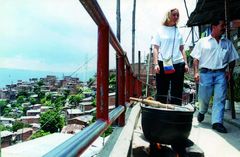
Italian volunteer Delia Innocenti during an accompaniment to Comuna 13. [Photo: Jorge Mata/Surimages-IPA]
Article published in the special Newsletter '15 years of PBI', October 2009
Peter Biermann, volunteer from Germany (2008-9)
In 2002, the security forces carriy out Operation Orion in the District 13, which results in one death, 28 wounded and 355 detentions. According to local human rights organisations, forced disappearances are also a pattern of repression.
«More than a thousand armed Army, Police, Department of Administrative Security and Technical Investigation Unit officers (...) arrived in District 13 in Medellin in lorries and armoured tanks»1. In the same year, there was a series of operations against the militia of the Comandos Armados del Pueblo (CAP), ELN and FARC in this area: Operations Otoño, Contrafuego, Mariscal, Potestad and Antorcha 2.
Nelly Osorno of the Popular Training Institute (IPC) remembers how in May, during the Mariscal Operation, the inhabitants held up white handkerchiefs and clothing and went out into the street in the middle of the confrontations 3. This mobilisation got the fighting to stop. Adriana Arboleda of the Corporation Judicial Freedom (CJL) recounts that they were able to organise a verification mission comprised of a member of CJL, accompanied by PBI, together with the Human Rights Ombudsman Office and United Nations, that created enough pressure to stop the operation and to avoid further risk to the communities.
CJL and IPC have worked in District 13 for several years. In the mid-1990s, the IPC began a training and education process with women in some neighbourhoods and developed production chains in the textile sector whilst CJL carried out human rights trainings with leaders of community action groups, young people and neighbourhood committees in District 13. Adriana remembers that there was a strong social movement there. Nelly explains that many neighbourhoods sprang up as shantytowns and «of course, they had to build their houses and pavements together in solidarity with their neighbours».
A 2003 report cites one death, 28 injuries and 355 arrests as the effects of Operation Orion on the civilian population 4. «There was a complete siege and no-one could get in»5. In the following months, the military walked around together with hooded men. Nelly remembers very clearly how one unfounded accusation led to the arrest of three leaders of the Women’s Association of the Independencias neighbourhood (AMI). «When I was informed of her detention, we ran out as fast as we could to the base in the El Corazón neighbourhood, but they wouldn’t let us enter. At dawn, the women’s place of detention was changed several times; but there was always one of us following the police car so as not to lose track of the prisoners». Adriana continues: «We had denounced that one of the patterns of repression in District 13 was forced disappearance, especially of young people, in the months following the operations». Later they would report the appearance of paramilitary groups: «We started to see new people, many from Uraba. The paramilitaries began to take control»6.
She concludes: «One of the major negative impacts of the operation was the distrust it created between people, because no-one knew who was who. So Operation Orion changed the question regarding what to do with the organisations: first we had to rebuild trust».
As a result of these events, CJL decided to warn people and raise awareness this operation, which they viewed as a comprehensive militarisation strategy in the city. The organisation increased its presence in the north-eastern part of the city where it accompanied the Internally Displaced Persons Settlements for Peace and Human Rights with the Seeds of Liberty Human Rights Collective (CODEHSEL). «Of course we went there with PBI and we organised joint embassy visits», Adriana remembers. However, in January 2003, the Army and the Police began Operation Estrella 6 in those same settlements. A CODEHSEL communiqué from that time reports that they raided houses and arrested around 100 people 7.
Human rights violations reported in District 13 after the military operations led CJL to begin work with victims’ family members. This work is continued up to the present, for instance demanding the exhumation of mass graves in La Escombrera in District 138.
--
1 «Comuna 13, la otra versión», CINEP and CIJP, Political violence database, May 2003
2 «Memoria histórica de la Comuna 13 de Medellín», Elkin Ramírez (CJL), 26 February 2008
3 Entrevista con Nelly Osorno, IPC, 6 August 2009
4 «Comuna 13, la otra versión», Political Violence Database, CINEP and CIJP, May 2003
5 Interview with Adriana Arboleda, CJL, 8 August 2009
6 Interview with Nelly Osorno, IPC, 6 August 2009 and «Comuna 13, la otra versión»
7 «Advierten sobre un estado de excepción de facto en Medellín», CODEHSEL, 8 December 2004
8 «Diego Fernando Murillo reconoce coordinación con la Fuerza Pública en la Operación Orión», CJL, 3 March 2009
